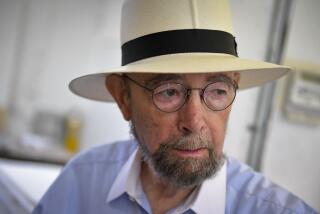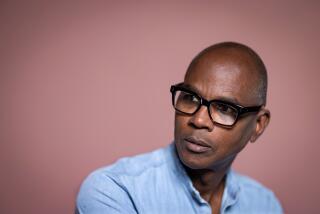Book Review: A dealer and his galaxy of art stars in ‘Leo and His Circle”
Leo and His Circle
The Life of Leo Castelli
Annie Cohen-Solal
Translated from the French by Mark Polizzotti
Alfred A. Knopf: 544 pp., $35
The ascension of New York gallerist Jeffrey Deitch to the Museum of Contemporary Art’s helm has occasioned considerable art-world hand-wringing as to the collapsing space between the market and the museum. Of course, these two zones have really never been separate. The dealer Joseph Duveen was the invisible hand responsible for building museum collections across the United States in the first half of the 20th century. No figure has played quite so forceful a role in the postwar years, but if anyone came close, it was Leo Castelli, the dapper New York dealer who is the subject of Annie Cohen-Solal’s elegant new biography, “Leo and His Circle.” Deitch’s career illustrates this point; the capital he used to open his gallery came from a commission earned selling works for Castelli.
Castelli, who died in 1999 at the age of 91, was the very picture of European suavity. Trim, impeccably dressed and gracious to a fault, he seemed a kind of continental aristocrat of the imagination. Which he was. If Castelli’s persona was not entirely fictional, it was certainly a construction. Like Duveen before him, Castelli was an immigrant Jew, born Leo Krausz to an upper-middle-class family in the then Austro-Hungarian port city of Trieste. (When the city became part of Italy after World War I, the family changed its name to Castelli.) A taste for the high life was bred in the Castelli genes. In 1867, his great-grandfather won a fortune playing the lottery, and squandered it in short order on a life of luxury.
Of Castelli’s family history, Cohen-Solal provides more information than the average reader, especially one hoping for a gossipy art-world tell-all, may be willing to bear. Indeed, she has practically created two independent books joined at the middle, one examining the Castelli family’s trials and tribulations over five generations, the second picking up in detail after Leo’s arrival in the U.S. in 1941, a refugee from the Nazi extermination machine. Both, it should be said, are well worth reading.
Castelli’s escape from Europe came via the immense wealth of his father-in-law, the Romanian industrialist Mihai Schapira. Castelli had married his daughter, Ileana, in 1933, in Bucharest, where he was building a career in the insurance business that held little interest for him. Schapira money kept the couple afloat in their early New York years, as Leo worked to make a place for himself in the art world. He was hardly an overnight success, even if it seemed so later on. As Cohen-Solal writes, his apparent “lightning metamorphosis from dilettante dandy and financial dependent to master gallerist” was in fact the product of “sixteen years of taxiing on the runway around New York.”
It took awhile, but Castelli had positioned himself well. Postwar New York was the right place for a savvy facilitator with a good eye, deep pockets and access to society. He soon attached himself to the pioneering gallerist Sidney Janis, one of the early proponents of Abstract Expressionism. He also attached himself to the artists themselves. Leo and Ileana (who would later open her own gallery, Sonnabend, after their divorce) were two of only three non-artist members of the Club, an influential coterie founded in 1949 that included Willem de Kooning, Robert Rauschenberg, Franz Kline and Ad Reinhardt. Two years later, he was instrumental in putting together the group’s pivotal Ninth Street Show, featuring a virtual who’s who of the American avant-garde.
Castelli didn’t open his own gallery — actually, a converted bedroom in his Upper East Side apartment — until 1957, and it was another year before he made his biggest splash, the first solo exhibition of a promising Southerner not yet 30: Jasper Johns. Castelli had seen his work in a group show at New York’s pioneering Jewish Museum, but the “discovery” came only when Castelli was taking a studio tour of another young Southerner who’d also shown in the museum’s exhibition: Rauschenberg. The two artists (neither Jewish) were neighbors and shared a fridge. When Castelli wanted ice in his drink, there was Johns, surrounded by his painted flags and targets and alphabets. Castelli signed them both.
Castelli was innovative and generous in dealing with his artists. His policy of paying stipends was practically unheard of in the business. In the words of James Rosenquist, he “radically transformed the relationship between collectors and artists.” That is, he turned artists into stars, with astronomical prices to match. He developed a stable that now defines American art of a certain era. Johns, Rauschenberg and Andy Warhol were his holy trinity, but the group also included luminaries such as Richard Artschwager, Lee Bontecou, John Chamberlain, Dan Flavin, Donald Judd, Ellsworth Kelly, Roy Lichtenstein, Claes Oldenburg, Rosenquist, Richard Serra, Frank Stella and Cy Twombly.
Cohen-Solal narrates Castelli’s career with a sense of deep admiration and abiding affection. She grants that she was practically adopted into the Castelli family upon her arrival in the U.S. as a French cultural diplomat in the late 1980s. This proximity allows for some revealing insights, in particular into Castelli’s manipulation of a prize at the 1964 Venice Biennale for Rauschenberg, an important moment for American art. But though she is diligent in her reconstruction of the Castelli family history back to the Renaissance, she treads gently on her subject’s personal foibles, in particular his philandering. It is a portrait as charmingly discreet as its subject.
Perhaps that is as it should be, and in any case, Cohen-Solal does the great service of showing just how the art world metastasized into a big business driven by celebrity artists represented by celebrity dealers. At its very core is a deep irony. Castelli, despite his elegant trappings, was hardly a great capitalist, and never actually made that much of a profit as a dealer. The man who was, for years, the world’s most notorious big-money gallerist was in it for the art.
Lamster is at work on a biography of Philip Johnson.
More to Read
The biggest entertainment stories
Get our big stories about Hollywood, film, television, music, arts, culture and more right in your inbox as soon as they publish.
You may occasionally receive promotional content from the Los Angeles Times.










